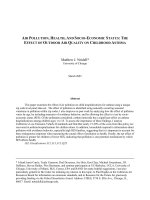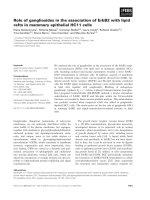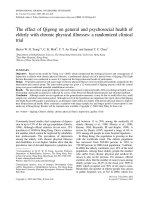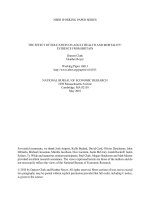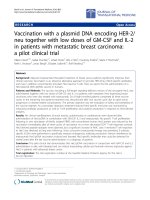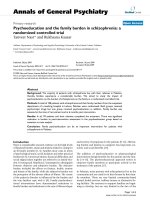The effect of Qigong on general and psychosocial health of elderly with chronic physical illnesses: a randomized clinical trial doc
Bạn đang xem bản rút gọn của tài liệu. Xem và tải ngay bản đầy đủ của tài liệu tại đây (93.75 KB, 9 trang )
INTERNATIONAL JOURNAL OF GERIATRIC PSYCHIATRY
Int J Geriatr Psychiatry 2003; 18: 441–449.
Published online in Wiley InterScience (www.interscience.wiley.com). DOI: 10.1002/gps.861
The effect of Qigong on general and psychosocial health of
elderly with chronic physical illnesses: a randomized clinical
trial
Hector W. H. Tsang
1
*, C. K. Mok
2
, Y. T. Au Yeung
2
and Samuel Y. C. Chan
3
1
Department of Rehabilitation Sciences, The Hong Kong Polytechnic University, Hong Kong
2
Tuen Mun Hospital, Hong Kong
3
Haven of Hope Nursing Home, Hong Kong
SUMMARY
Objectives Based on the model by Tsang et al. (2002) which summarized the etiological factors and consequences of
depression in elderly with chronic physical illnesses, a randomized clinical trial of a special form of Qigong (The Eight
Section Brocades) was conducted to assess if it improved the biopsychosocial health of participants.
Design 50 geriatric patients in sub-acute stage of chronic physical illnesses were recruited and randomly assigned into the
intervention and control group. The intervention group was given a 12-week period of Qigong practice while the control
group was given traditional remedial rehabilitation activities.
Results The intervention group participants expressed improvement in physical health, ADL, psychological health, social
relationship, and health in general as reflected by scores of the Perceived Benefit Questionnaire and informal feedback.
Conclusion Although results are not significant in the generalization measures, it may be due to small effect size, small
sample size, and short intervention period. Although not all of the hypotheses are supported, this report shows that Qigong
(the Eight Section Brocades) is promising as an alternative intervention for elderly with chronic physical illness to improve
their biopsychosocial health. More systematic evaluation with larger sample size and longer period of intervention is now
underway in Hong Kong. Results will be reported once available. Copyright # 2003 John Wiley & Sons, Ltd.
key words — Qigong; Chinese elderly; chronic physical illness; depression; quality of life
Community-based studies find symptoms of depres-
sion in up to 15% of the old age population (Dunitz,
1996). Although official statistics do not exist, 15%
translates to 114 000 in Hong Kong. This is a substan-
tial number which cannot be neglected by rehabilita-
tion professionals. The prevalence of depression
among the elderly with chronic physical illnesses
and disabilities is even higher. Studies show that the
prevalence rate of elevated depressive symptoms ran-
ged between 11 to 59% among the medically ill
elderly (Koenig et al., 1988; Mossey et al., 1990;
Katona, 1994; Reynolds, III and Kupfer, 1999). A
review by Dunitz (1997) reported a range of 6% to
45% among old people in acute hospital inpatients.
In Hong Kong, the population is growing in line
with the worldwide trend. The elderly population
has increased from 502 400 persons in 1991 to
729 200 persons in 2000 (total population, 7 million).
In 2000, the elderly constitutes over 10% of the total
population. Among these elderly people the number
who suffer from chronic physical and medical ill-
nesses is also on the increase. For instance, official
statistics show that the number of cancer cases among
elderly people was 10 473 in the fiscal year 1999 to
2000, which occupied over 50% of all cancer cases.
Meanwhile, the number of elderly people who stayed
in public hospitals was 11 543 in 2000, which was
Received 5 November 2002
Copyright # 2003 John Wiley & Sons, Ltd. Accepted 27 February 2003
* Correspondence to: Dr H. W. H. Tsang, Associate Professor,
Department of Rehabilitation Sciences, The Hong Kong Poly-
technic University, Hung Hom, Hong Kong. Tel: 852 2766 6750.
E-mail:
Website: />Contract/grant sponsor: Area of Strategic Development Grant
(ASD), Department of Rehabilitation Sciences, The Hong Kong
Polytechnic University (Principal Investigator: Professor Christina
Hui-Chan).
again nearly half of all in-patients in public hospitals.
Although lacking in empirical evidence, clinical
experience shows that being hospitalized is common
for those who suffer from different chronic illnesses
(e.g. Parkinson’s disease, Alzheimer’s disease, cere-
brovascular disease, dementia, cancer, and cardiopul-
monary disease, etc.). In a local study, we found that
80% of the elderly aged 60 or over who committed
suicide had severe or terminal illness and 24% had a
history of psychiatric treatment that was strongly
related to depression.
Although the relationship between physical pro-
blems and depression is well documented, the under-
lying mechanism is basically unknown. Studies show
that depression among elderly has serious adverse
health consequences including a drop in immune
function. A theory was put forward by Tsang et al.
(2002) summarizing the etiological factors and conse-
quences of depression in elderly with chronic physical
illnesses (Figure 1).
Literature shows that exercise has been used with
success to elevate mood and improve general health
of elderly. Shephard (1990) discussed the scientific
basis of exercise and pointed out that advantages of
exercise included improvement of health, increased
opportunities for social contacts, gains in cerebral
function, enhancement of mood, greater self-esteem,
and stronger self-efficacy. Paillard and Nowak (1985)
reported that an exercise program was able to increase
activity tolerance, improve range of motion and mobi-
lity, and improve affect and mood in a group of 70
elderly patients. In a study using aerobic exercise as
the treatment protocol among a group of 81 healthy
elderly aged between 60 and 81, it was found that
the treatment was successful in improving physical
functions, self-rating of mood, and perceived health
status (McMurdo and Burnett, 1993). However,
experience showed that Chinese elderly people may
not be interested in aerobic exercise with a western
cultural origin. This article reported a preliminary
clinical trial of Qigong, a form of Chinese therapeu-
tics, as a psychosocial intervention to alleviate
depression and thus improve psychosocial well-being
among Chinese elderly with chronic physical illness.
Qigong has a long history with diverse schools in
China. A more detailed description of the history
and origins of Qigong can be found in Tsang et al.
(2002). Qigong can be simple and complex. It is dif-
ficult to give a clear definition to qigong, but it is pos-
sible to identify the common features of qigong
(Brown and Knoferl, 2001). There are three main fea-
tures of qigong: postures and movement, state of
mind, and breathing. The aim of practicing qigong
is to cultivate qi to help the organism stay healthy
and vital. In China, health and longevity are deter-
mined by strength, balance and cultivation of the three
treasures: jing (essence), qi (energy) and shen (spirit).
Qigong focuses on these three treasures to represent a
holistic view of the human being.
Eight-Section Brocades is one of the many forms of
health-promoting Chinese qigong that can easily be
learnt. It is less physically and cognitively demanding
when compared with Tai Chi. There is no clear evi-
dence as to when the Eight-Section Brocades were
first developed. Olson (1997) stated that it may have
be created by Tao Hung-ching, a Taoist adept from the
fifth century AD. Others think that it was created by
Chung-li Chuan, a follower of Tao Hung-ching, who
invented them.
The Eight-Section Brocades first appeared in Tao
Hung-ching’s record on Cultivating Longevity.Itis
thought that Chung-li chuan, who studied with Tao,
had received the transmission of these eight forms
and revised them as the Eight-Section Brocades.
Other theories suggest that the Eight-Section Bro-
cades is a collection of various Daoyin exercises.
Eight-Section Brocades has two training methods:
The Sitting-Style Eight-Section Brocades and the
Standing-Style Eight-Section Brocades. From a clin-
ical point of view, it means that it can be practiced by
Figure 1. Etiology and consequences of depression in elderly
(Tsang et al., in press)
442 h. w. h. tsang
et al.
Copyright # 2003 John Wiley & Sons, Ltd. Int J Geriatr Psychiatry 2003; 18: 441–449.
the more vulnerable people who have poor standing
balance are wheel-chair bound. The Standing-Style
Eight-Section Brocades are:
1. Prop Up the Sky with Both Hands to Regulate the
Triple Warmer
2. Draw a Bow on Both sides like Shooting a Vulture
3. Raise Single Arm to Regulate Spleen and Stomach
4. Look Back to Treat Five Strains and Seven Impair-
ments
5. Sway Head and Buttocks to Expel Heart-Fire
6. Pull Toes with Both Hands to Reinforce Kidney
and Waist
7. Clench Fists and Look with Eyes Wide Open to
Build up Strength and Stamina
8. Rise and Fall on Tiptoes to Dispel All Diseases
Qigong is a complete exercise for both the body
and the mind. Li and Sun (1997) stated that when peo-
ple practice Qigong on a regular basis, it can posi-
tively influence the breathing, heart, digestion,
blood circulation, nervous system, metabolism, and
keep the body’s biological processes in a steady and
fluid motion. Physiological studies have been con-
ducted on Qigong practitioners. The results show that
regular practice of Qigong will lead to decrease in
heart rate, respiratory rate, oxygen consumption and
metabolic rate. Li and Sun (1997) stated that practice
of Qigong could help to prevent heart disease. It can
regulate blood pressure and strengthen the heart by
setting the body and mind at ease.
Although empirical evidence is not available, it has
been suggested that Qigong has a similar effect to
antidepressants (Yu, 1999). This may be because
Qigong practice has an emphasis on breathing relaxa-
tion. When the body and mind are calm, a person’s
physical and mental functions are better. Correct pos-
turing, proper movements, clearing mind of stray
thoughts, and long and deep breathing, all help a per-
son achieve a state of well-being and reduce mental
and physical tension. It may further help to improve
the sense of self-efficacy and mastery. It has been
reported that the practice of Qigong is useful in relie-
ving symptoms of depression and is helpful to
improving for the quality of sleeping in older people
(Tang and Wang, 1990; Tang, 1994).
We hypothesized in this study that Qigong would
elevate the mood, improve the physical, psychologi-
cal and social relationship of Chinese elderly with
chronic physical illnesses as shown by our outcome
and generalization measures.
METHOD
Participants
A group of 50 geriatric patients (26 males and 24
females) in sub-acute stage of Cardiovascular Acci-
dent (CVA) (31), Chronic obstructive pulmonary dis-
ease (COPD) (5), Parkinson’s disease (4), rheumatoid
arthritis (3), and other chronic medical conditions (7),
were recruited from the geriatric day hospital of Tuen
Mun Hospital and the Haven of Hope elderly home.
All of the participants showed willingness to join a
Qigong practice group supervised by a qualified prac-
titioner, had good sitting balance, and a minimum
shoulder forward abduction range of 50 degree in
one hand as assessed by the case occupational
therapist. The participants were randomly allocated
into the intervention and control groups respectively.
The mean age was 72.9 (SD ¼ 9.5) for the inter-
vention group and 76.3 (SD ¼ 8.4) for the control
group. The Chinese version of the Geriatric Depres-
sion Scale (GDS; Yesavage et al., 1983) showed that
all participants suffered to a degree from depressed
mood, even though they did not carry a clinical
diagnosis of depression. Comparison statistics
showed that the participants in these two groups did
not differ from each other significantly indicating
the allocation process was genuinely random. The
demographic data of the participants are summarized
in Table 1.
Outcome measures
The Geriatric Depression Scale (GDS; Yesavage et al.,
1983). The 30-item questionnaire with ‘Yes/No’
answers was adopted to assess the degree of depressed
mood. This questionnaire was translated to Chinese
which is now commonly used by rehabilitation
professionals in Hong Kong. Local validation studies
showed that is it reliable and valid (Chiu et al., 1993;
Wong et al., 2002).
Perceived Benefit Questionnaire. A 21-item ques-
tionnaire (five-point scale with 1 indicating very
negative feedback, 3 indicating neutral feedback, and
5 indicating very positive feedback) tapping their
perceived improvement in physical health, activities
a clinical trial on qigong 443
Copyright # 2003 John Wiley & Sons, Ltd. Int J Geriatr Psychiatry 2003; 18: 441–449.
of daily living, psychological health, social relation-
ship, and health in general was developed for this
study. Items were generated based on literature and
clinical experience of researchers. This was to
evaluate the perceived benefits of the completed
intervention program (see Table 2). The items were
finally included based on the feedback of the clients
of a pilot study of similar kind. The final version
was assessed for its psychometric properties in a
group of 22 elderly with the same selection criteria as
the present study. The coefficient alpha of the
questionnaire is 0.88. Test–retest reliability as
reflected by ICC is 0.91 with subscales ranging from
0.60 to 0.87.
Generalization measures
Quality of life. Participants’ self-perceived quality of
life was measured by the Hong Kong Chinese Version
World Health Organization Quality of Life: Abbre-
viated Version (WHOQOL-BREF[HK]) Question-
naire. The questionnaire consists of 28 questions on
a five-point scale. This indicated that the whole
spectrum of the five-point scales was utilized in the
reflection of quality of life of the participants (Leung
et al., 1997). The questions were further categorized
into four domains, including physical health domain,
psychological domain, social relationship domain
and environment domain. The Cronbach alpha values
Table 1. Demographic characteristics of participants I
Control (n ¼ 26) Experimental (n ¼ 24) Total (n ¼ 50)
2
p-value
Gender
Male 17 (34.6%) 9 (65.4%) 26 (52.0%) 3.89 0.05
Female 9 (37.5%) 15 (62.5%) 24 (48.0%)
Education
Illiterate 6 (23.1%) 7 (29.2%) 13 (26.0%) 1.66 0.647
Primary 13 (50.0%) 14 (58.4%) 27 (54.0%)
Secondary 5 (19.2%) 2 (8.3%) 7 (14.0%)
Tertiary 2 (7.7%) 1 (4.1%) 3 (6.0%)
Marital status
Single 1 (3.9%) 3 (12.5%) 4 (8.0%) 1.27 0.53
Married—deceased 12 (46.1%) 10 (41.7%) 22 (44.0%)
Married—alive 13 (50.0%) 11 (45.8%) 24 (48.0%)
Diagnosis
COPD 5 (19.2%) 0 (0.0%) 5 (10.0%) 6.58 0.16
CVA 15 (57.7%) 16 (66.6%) 31 (62.0%)
RA 2 (7.7%) 1 (4.2%) 3 (6.0%)
Parkinson 2 (7.7%) 2 (8.4%) 4 (8.0%)
Others 2 (7.7%) 5 (20.8%) 7 (14.0%)
Live with whom
Family 4 (14.4%) 5 (20.8%) 9 (18.0%) 0.47 0.79
Spouse 2 (7.7%) 1 (4.2%) 3 (6.0%)
Alone 20 (76.9%) 18 (75.0%) 38 (76.0%)
Life roles
Retired 26 (100.0%) 24 (100.0%) 50 (100.0%) N.A. N.A.
Financial source
Family 4 (15.4%) 4 (16.6%) 8 (16.0%) 3.68 0.719
Savings 0 (0.0%) 1 (4.2%) 1 (2.0%)
NDA/HDA 2 (7.7%) 2 (8.4%) 4 (8.0%)
CSSA 7 (26.9%) 8 (33.3%) 15 (30.0%)
Allowances 6 (23.1%) 5 (20.8%) 11 (22.0%)
Family þ saving 0 (0.0%) 1 (4.2%) 1 (2.0%)
Family þ allowance 7 (26.9%) 3 (12.5%) 10 (20.0%)
Demographic characteristics of participants II
Control (n ¼ 26) Experimental (n ¼ 24)
MSD M SDtp-value
Age 76.27 8.40 72.93 9.53 1.32 0.19
MMSE 25.54 3.62 24.75 3.86 0.75 0.46
444 h. w. h. tsang
et al.
Copyright # 2003 John Wiley & Sons, Ltd. Int J Geriatr Psychiatry 2003; 18: 441–449.
of the four domains in the questionnaire ranged from
0.67 in domain 3 (social relationship) to 0.79 in
domain 2 (psychological), which showed that the
questionnaire had good internal consistency and ready
for clinical use. The intra-class correlation coefficient
of question scores between first test and re-test within
one month ranged from 0.64 to 0.90 which showed
that the WHOQOL-BREF(HK) Questionnaire had fair
to good test–retest reliability.
Self-concept Scale (ASSEI; Tam, 1995). This 20-item
scale was used to measure self-esteem of participants
in different areas of their lives such as physical,
social, ethical, familial, and intellectual. The ASSEI
was found to be construct and content valid for the
Hong Kong population.
Procedure
All intervention and control group participants in this
study received basic rehabilitation activities including
self-care training, remedial activities, and educational
programs, etc. Participants in the intervention group,
however, received one hour practice of qigong, twice
a week, under the supervision of a qualified practi-
tioner, on top of the basic rehabilitation activities.
The Eight-Section Brocades described earlier were
used as the intervention protocol.
They were slightly modified for practice in a sitting
position for those who were wheelchair-bound or
could not stand for a long time. The participants were
asked to practice it daily, under the supervision of
their relatives (who were also trained by the practi-
tioner) for at least 30 minutes. The intervention lasted
for 12 weeks. The control group received the same
amount of traditional remedial rehabilitation activ-
ities under the supervision of qualified professionals
so as to neutralize the effect of staff’s additional atten-
tion during the Qigong practice.
The Geriatric Depression Scale (GDS) was admi-
nistered one week before, mid-way, and one week
after the intervention for both groups of participants.
For the intervention group, the Perceived Benefit
Questionnaire was implemented one week after the
completion of the program. In addition, feedback
from the participants in the intervention group was
collected via discussion every two to three weeks after
the beginning of the practice.
Data analyses
The demographic characteristics and scores of the
participants on the outcome and generalization mea-
sures were summarized by descriptive statistics. The
comparison of groups in terms of their pre-interven-
tion demographic characteristics was performed by
simple t-test or chi-square test. The effect of Qigong
among the groups during the pre-intervention, mid-
way, and post-intervention were studied by means
of repeated measures ANOVA. The qualitative feed-
back from the participants was content analysed.
RESULTS
Outcome measures
Results based on the Perceived Benefit Questionnaire
(Table 3) showed that the participants of the interven-
tion group after the intervention program indicated
improvement in physical health (19.36, t(21) ¼ 7.34,
p < 0.001), ADL (7.41, t(21) ¼ 6.89, p < 0.001), psy-
chological health (26.73, t(21) ¼ 9.22, p < 0.001),
social relationship (11.05, t(21) ¼ 4.95, p < 0.001),
and health in general (7.5, t(21) ¼ 6.65, p < 0.001).
Repeated Measures ANOVA of the Geriatric Depres-
sion Scale (Table 4) of these two groups is however
not significant (F(2, 39) ¼ 2.032, p ¼ 0.145).
Feedback from participants of the intervention group
As to qualitative results, the followings are extracted
feedback from randomly selected participants in the
intervention group:
Table 2. Perceived benefit questionnaire
Physical health
1. Reduce your pain in the limbs
2. Reduce stiffness of your limbs
3. Increase the mobility of your limbs
4. Make you more energetic
5. Increase your trunk balance
Activities of daily living
6. Improve your ability to walk
7. Improve your ability to get around
8. Improve your sleep
9. Improve your appetite
Psychological
10. Make you happier
11. Help you to relax
12. Help you to concentrate
13. Reduce your feeling of anxiety
14. Reduce your feeling of despair
15. Make you more optimistic
16. Increase your self-confidence
Social relationship
17. Let you make more friends
18. Improve your relationship with your family members
19. Make you more satisfied with your social relationship
Overall
20. Improve your health
21. Improve your quality of life
a clinical trial on qigong 445
Copyright # 2003 John Wiley & Sons, Ltd. Int J Geriatr Psychiatry 2003; 18: 441–449.
Feedback after less than six weeks of practice
Subject 1
No comment regarding psychosocial functioning.
Subject 2
‘At the beginning, my affected side was painful when
I raised up my upper limb. After practicing it, I felt
more comfortable, relaxed, and less painful in my
affected arm.’
Subject 3
‘I feel more relaxed.’
Subject 4
‘Before the practice, my upper limb of the affected
side could only raise up a little. Now, both hands
could raise above my head.’
Subject 5
No comment regarding psychosocial functioning.
Subject 6
‘I have practiced it for 3 weeks. The condition is more
or less the same. No obvious improvement is noted.’
Subject 7
No comment regarding psychosocial functioning.
Subject 8
‘I could not sleep before started practicing Qigong.
Now I sleep better.’
Feedback after more than six weeks of practice
Subject 1
‘Now I can sleep well.’
Subject 2
‘I feel better and more relaxed.’
Subject 3
‘I feel better, more comfortable and sleep well.’
Subject 4
‘I have practiced it for six weeks. My mobility of both
upper and lower limbs improved. I feel relaxed and
better.’
Subject 5
No comment regarding psychosocial functioning.
Subject 6
‘I feel more comfortable.’
Subject 7
No comment regarding psychosocial functioning.
Subject 8
‘I could not sleep before I practiced Qigong. Now I
sleep much better. I feel more optimistic when I
thought about my illness.’
Generalization measures
The results of the self-concept scale and quality of life
measure are summarized in Tables 5 and 6. There is
no significant difference in terms of time and group
effects.
DISCUSSION
Results from the Perceived Benefit Questionnaire
indicated very positive feedback from the participants
in the intervention. Most of them felt that the practice
of Qigong could improve their health in different
aspects, including psychological and social. This
provides the first piece of evidence that the practice
Table 3. Sub-scale scores of experimental group after Qigong
Practice—one sample t-test
Sub-scales M SD t df p-value
Physical health 19.36 2.79 7.34 21 < 0.001
ADL (General) 14.75 2.12 3.67 7 0.008
ADL (Mobility excluded) 7.41 0.96 6.89 21 < 0.001
Psychological health 26.73 2.91 9.22 21 < 0.001
Social relationship 11.05 1.94 4.95 21 < 0.001
Others 7.50 1.06 6.65 21 < 0.001
Table 4. Scores of Geriatric Depression Scale of control and experimental group at three different stages
Pre-treatment Midway Post-treatment ANOVA with
repeated
Control Experimental Control Experimental Control Experimental measure
F-ratio p-value
M SD M SD M SD M SD M SD M SD
Geriatric 6.05 3.40 7.39 3.91 6.68 4.36 5.91 3.61 5.16 4.14 6.13 4.14 2.032 0.145
Depression
Scale (GDS)
446 h. w. h. tsang
et al.
Copyright # 2003 John Wiley & Sons, Ltd. Int J Geriatr Psychiatry 2003; 18: 441–449.
of Qigong is beneficial to depressed elderly with
chronic physical illnesses. Although subjective in nat-
ure, the results reflect that the participants are opti-
mistic that the practice of this traditional Chinese
therapeutics is good to their health. This is in line with
the previous literature about the benefits of Qigong
(e.g. Tang and Wang, 1990). The qualitative feedback
from the participants showed that six of them (75%)
felt better in terms of their psychosocial functioning
after the 12-week program. Before six weeks of prac-
tice, only three (37.5%) however reported improve-
ment. At an early stage, the feedback centered
around physical function such as movement of the
limbs and activities of daily living. At a later stage,
the feedback then shifted more to psychological
aspects. The improvement included feeling more
relaxed, more comfortable, better sleep, and being
more optimistic. All reported improvements in psy-
chosocial functioning are indicative of less depressed
mood and higher quality of life. As Chinese people
are more conservative in terms of emotion expression,
it is not surprising to see that few directly commented
that they felt ‘less depressed’. In addition, this is con-
sistent with the clinical observation during their parti-
cipation in the intervention program. Staff members
reported that even those who were reluctant to take
part in other remedial rehabilitation programs were
motivated to participate in the Qigong program.
Although there was no follow-up data collection for
this study, staff observed that nearly 50% of the
participants in the intervention group continued to
practice the learned Qigong exercise up to six months
after the completion of the project. This again con-
firms the argument (Tsang et al., 2002) that culturally
relevant activities have a special attraction to Chinese
elderly.
Although the F-ratio of the Geriatric Depression
Scale is not significant, this may probably be due to
Table 5. Scores of self-esteem of control and experimental group at three different stages
Pre-treatment Midway Post-treatment ANOVA
with
Control Experimental Control Experimental Control Experimental repeated
measure
M SD M SD M SD M SD M SD M SD F-ratio p-value
Personal 17.80 3.76 14.70 4.37 18.05 3.44 16.22 3.29 18.45 3.66 16.70 2.88 0.609 0.549
Quality
Family 34.78 8.30 34.5 6.31 38.72 2.99 36.6 3.62 35.00 1.65 34.55 2.65 1.054 0.359
relationship
Social 31.37 7.24 31.45 5.38 31.53 3.06 30.64 3.63 30.74 3.57 29.64 3.27 0.127 0.881
relationship
Daily tasks 8.90 2.10 8.78 3.01 10.65 3.12 9.87 2.44 8.20 2.02 7.74 1.57 0.247 0.782
Leisure 10.00 2.68 9.31 2.48 11.75 2.07 11.09 1.86 11.00 1.45 10.74 1.51 0.291 0.749
Material 15.33 3.46 15.26 3.84 12.94 3.04 12.70 2.44 12.50 1.38 12.91 2.17 0.235 0.792
Physical 12.00 3.20 11.74 3.31 13.90 2.51 13.48 2.06 14.40 1.79 13.09 1.88 1.328 0.276
well being
Others 24.55 7.23 24.27 5.71 23.05 3.98 22.81 2.70 23.10 3.70 23.82 4.29 0.304 0.740
Table 6. Score of quality of life (WHOQOL) of control and experimental group at three different stages
Pre-treatment Midway Post-treatment ANOVA
with
Control Experimental Control Experimental Control Experimental repeated
measure
M SD M SD M SD M SD M SD M SD F-ratio p-value
General 6.95 1.28 6.17 1.72 7.10 1.37 7.08 0.85 7.25 1.21 6.83 1.23 1.359 0.269
health
Social 7.20 1.44 6.91 1.44 6.90 1.17 6.86 1.17 7.25 0.97 7.00 0.87 0.216 0.807
relationship
Physical 15.85 2.81 16.9 2.15 17.3 3.47 15.83 2.79 17.60 2.37 15.48 2.52 4.97 0.012
health
Psychological 24.74 3.83 23.29 6.21 26.53 4.61 24.81 4.15 25.05 3.05 23.00 3.92 0.096 0.909
Environment 26.44 5.01 25.81 3.46 27.44 3.22 26.00 2.14 26.44 2.20 25.38 2.13 0.31 0.735
a clinical trial on qigong 447
Copyright # 2003 John Wiley & Sons, Ltd. Int J Geriatr Psychiatry 2003; 18: 441–449.
small effect size in the scores between the two groups.
If a larger sample size had been used, a p value less of
than 0.05 may have been obtained. As to the general-
ization measures, we do not feel surprised at this stage
of research to have obtained non-significant results.
We believe that significant results would eventually
be available when the intervention program was
camed out over a longer period of time (i.e. six to nine
months). Although the participants feel good about the
program, it takes time for these benefits to be interna-
lized into their life and their psychosocial aspects.
This preliminary report showed that Qigong (the
Eight Section Brocades) is promising as an alternative
psychosocial intervention for depressed elderly with
chronic physical illness. This is consistent with find-
ings from the literature that exercise is beneficial to
elderly in both physical and psychosocial aspect
(Shephard, 1990). Qigong has one obvious advantage
over foreign exercise protocols because it is culturally
relevant to Chinese elderly. Although evidence does
not exist, we hypothesize that Qigong will result in
better treatment compliance and hence better out-
come when compared to exercise protocols with wes-
tern origins such as aerobics. Studies are needed in the
future to test this claim. In addition, more systematic
evaluation using a larger sample and longer period of
intervention is now underway in Hong Kong. Results
will be reported once available.
ACKNOWLEDGEMENTS
We would like to give our sincere thanks to Professor
Christina Hui-Chan for the ASD fund injected to this
project. We are also grateful to Mr Larry Li, occupa-
tional therapist of Tai Po Hospital; Ms Winky Chan
and Cindy Chiu, occupational therapists of Tuen Mun
Hospital; Ms Y. T. Lam, Home Manager, Ms Dolly
Leung, former Home Manager; Ms C. S. Yeoh, Senior
Executive Manager/CHS & SRS of Haven of Hope
Nursing Home; and Mr Alvin Wong, research assis-
tant of The Hong Kong Polytechnic University, for
their professional input and assistance leading to
completion of this project.
REFERENCES
Bartels SJ, Mueser KT, Miles KM. 1997. Functional impairments in
elderly patients with schizophrenia and major affective illness in
the community: social skills, living skills, and behavioral pro-
blems. Behavior Ther 28: 43–63.
Beekam ATF, Pennix BWJH, Deeg DJH, et al. 1998. Depression in
survivors of stroke: a community-based study at prevalence, risk
factors and consequences. Soc Psychiatry Psychiatr Epidemiol
33(10): 463–470.
Blazer D. 1998. Emotional Problems in Later Life: Intervention
Strategies for Professional Caregivers. Springer Publishing
Company, Inc: New York.
Brown B, Knoferl G. 2001. Qigong: The Chinese Art of Working
with Energy. Thorsons: London.
Chen KM, Snyder M, Krichbaum K. 2001. Clinical use of Tai Chi in
elderly populations. Geriatric Nurs 22(4): 198–200.
Cheng ST. 1990. Health-care inflation: a missed opportunity. J
Commun Psychol 18: 210–217.
Cheng ST. 1992. Loneliness-distress and physician utilization in
well elderly females. J Commun Psychol 20: 43–56.
Chiu HFK, Lee HCB, Wing YK, et al. 1993. Reliability, validity
and structure of the Chinese Geriatric Depression Scale in
Hong Kong context: a preliminary report. Singapore Med J 35:
477–480.
Conwell Y. 1996. Suicide in elderly patients. In Diangosis and
Treatment of Depression in Late Life, Schneider LS, et al.
(eds). American Psychiatric Press: Washington, DC.
Dong P. 1990. Chi Gong: The Ancient Chinese Way to Health. Para-
gon House: New York.
Dong P, Esser AH. 1990. Chi Gong: The Ancient Chinese Way to
Health. Paragon House: New York.
Dunitz M. 1996. Depression in Elderly People. Gill Livingston:
Cornelius Katona.
Dunitz M. 1997. Comorbid Depression in Older People. Gill
Livingston: Cornelius Katona.
Engel GL. 1980. The clinical application of the biopsychosocial
model. Am J Psychiatry 137: 535.
Flaws B. 1993. On the historical relationship of acupunture and
herbal medicine in China and what this means politically in
the United States. Am J Acupunture 21(3): 267–278.
Fredman L, Schoenback VJ, Kaplan BH, et al. 1989. The associa-
tion between depressive symptoms and mortality among older
participants in the epidemiologic catchment area—Piedmont
Health Survey. J Gerontol 44: S149–S156.
Friedland J, McColl M. 1992. Disability and depression: some etio-
logical considerations. Social Sci Med 34: 395–403.
Goldberg DP, Williams P. 1988. A User’s Guide to the General
Health Questionnaire. NGER Nelson: Windsor.
Hays JC, Krishnan KRR, George LK, et al. 1997. Psychosocial and
physical correlates of chronic depression. Psychiatry Res 72:
149–159.
Herbert TB, Cohen S. 1993. Depression and immunity: a meta-ana-
lytical review. Psycholog Bull 113: 472–486.
Katona CLE. 1993. New antidepressants in elderly patients.
In Treatment and Care in Old Age Psychiatry, Levy R, Howard
R, Burns A (eds). Wrightson Biomedical Publsihing Ltd:
Petersfield; 157–168.
Katona CLE. 1994. Depression in Old Age. John Wiley: Chichester.
Kennedy GJ, Kelman HR, Thomas C. 1990. The emergence of
depressive symptoms in late life: the importance of delinc-
ing health and increasing disability. J Commun Health 15:
93–104.
Koenig HG, Meador KG, Cohen HJ, Blazer DG. 1988. Depression
in elderly hospitalized patients with medical illness. Arch Intern
Med 148: 1939–1946.
Leung KF, Tay M, Cheng SW, Lin F. 1997. Hong Kong Chinese
Version World Health Organisation Quality of Life Measure—
abbreviated version: Hong Kong Hospital Authority.
Li JX, Hong Y, Chan KM. 2001. Tai Chi: physiological character-
istics and beneficial effects on health. Br J Sports Med 35(3):
148–156.
Li XJ, Sun WY. 1997. Chi Kung: Increase Your Energy, Improve
Your Health. Sterling Publishing Co., Inc: New York.
448 h. w. h. tsang
et al.
Copyright # 2003 John Wiley & Sons, Ltd. Int J Geriatr Psychiatry 2003; 18: 441–449.
MaMurdo ME, Burnett L. 1992. Randomized controlled trial of
exercise in the elderly. Gerontology 38(5): 292–298.
Minoru H. 1985. Kikou Kenkoho. Tohan Corporation: Tokyo.
Mossey JM, Knott KA, Craik R. 1990. The effects of persistent
depressive symptoms on hip fracture recovery. J Gerontolog
Med Sci 45: M163–M168.
National Center for Health Statistics. 1992. Advance Report of
Final Mortality Statistics. Report No 40. Hyattsville, MD.
Olson SA. 1997. Eight Brocades: Seated Chi-Kung. Fade Forest
Publishers, Inc.: Minneapolis, MN.
Paillard M, Nowak KB. 1986. Use exercise to help older adults:
clients in acute care benefit from exercise/relaxation plan.
J Gerontolog Nurs 11 (7): 36–39.
Pearlin LL, Schooler C. 1978. The structure of coping. J Health
Social Behav 19: 2–21.
Penninx BWJH, Guralnik JM, Ferrucci L, et al. 1998. Depressive
symptoms and physical decline in community-dwelling older
persons. J Am Med Assoc 279(21): 1720–1726.
Reynolds CF, III, 1994. Treatment of depression in late life. Am J
Med 96(Suppl. 6A): S39–S47.
Reynolds CF, III, Alexopoulous GS, Katz IR, Lebowitz BD. 2001.
Chornic depression in the elderly: approaches for prevention.
Therapy in Practice 18(7): 507–514.
Reynolds CF, III, Kupfer DJ. 1999. Depression and aging: a look to
the future. Ment Health Aging 50(9): 1167–1172.
Robinson RG, Starr LB, Kubos KL, Price TR. 1983. A two-year
longitudinal study of post-stroke mood disorders: findings during
the initial evaluation. Stroke 14: 736–741.
Rubenowitz E, Waern M, Wilhelmson K, Allebeck P. 2001. Life
events and psychosocial factors in elderly suicides: a case-con-
trol study. Psycholog Med 31: 1193–1202.
Shephard RJ. 1990. The scientific basis of exercise prescribing for
the very old. J Am Geriatr Soc 38(1): 62–70.
Stuck AE, Walthert JM, Nikolaus T, et al. 1999. Risk factors for
functional status decline in community-living elderly people: a
systematic literature review. Soc Sci Med 48: 445–469.
Tam SF. 1995. Towards a hierarchical model of self-concept
for Hong Kong Chinese adults with physical diabilities. Int J
Psychol 30: 1–17.
Tang KC. 1994. Qigong Therapy—its effectiveness and regulation.
Am J Chinese Med XXII(3–4): 235–242.
Tang CJ, Wang ZL. 1990. The effect of Qigong on sleeping status of
the elderly. J Gerontol 10(2): 97–99; 1990.
Targum SD, Marshall LE, Fischman P, Martin D. 1989. Lympho-
cyte subpopulations in depressed elderly woman. Biologoical
Psychiatry 26: 581–589.
Tsang HWH, Cheung L, Lak D. 2002. Qigong as a psychosocial
intervention for depressed elderly with chronic physical ill-
nesses. Int J Geriatr Psychiatry 17(12): 1146–1154.
Wade TJ, Cairney J. 2000. The effect of sociodemographics,
social stresstors, health status and psychosocial resources on
the age-depression relationship. Can J Public Health 91(4):
307–312.
Wilkinson DG. 1993. ECT in the elderly. In Treatment and Care in
Old Age Psychiatry, Levy R, Howard R, Burns A (eds). Wright-
son Biomedical Publsihing Ltd: Petersfield; 169–182.
Wong MTP, Ho TP, Ho MY, et al. 2002. Development and inter-
rater reliability of a standardized verbal instruction manual for
the Chinese Geriatric Depression Scale—short form. Int J Ger-
iatr Psychiatry 17: 459–463.
Yesavage J, Brink T, Rose T, et al. 1983. Development and valida-
tion of a geriatric depression screening scale: a preliminary
report. J Psychiatric Res 17: 37–49.
Yu KP. 1999. Diagramatic Illustration of Chinese Chi-gong.Tai
Chin Publishing Co. Ltd: Tai Bei.
Zhang E. 1990. Chinese Qigong in a Practical English–Chinese
Library of TCM. Publishing House of Shanghai College of
Traditional Chinese Medicine: Shanghai.
Zwick D, Rochelle A, Choksi A, Domowicz J. 2000. Evaluation
and treatment of balance in the elderly: a review of the efficacy
of the Berg Balance Test and Tai Chi Quan. Neurorehab 15(1):
49–56.
a clinical trial on qigong 449
Copyright # 2003 John Wiley & Sons, Ltd. Int J Geriatr Psychiatry 2003; 18: 441–449.

